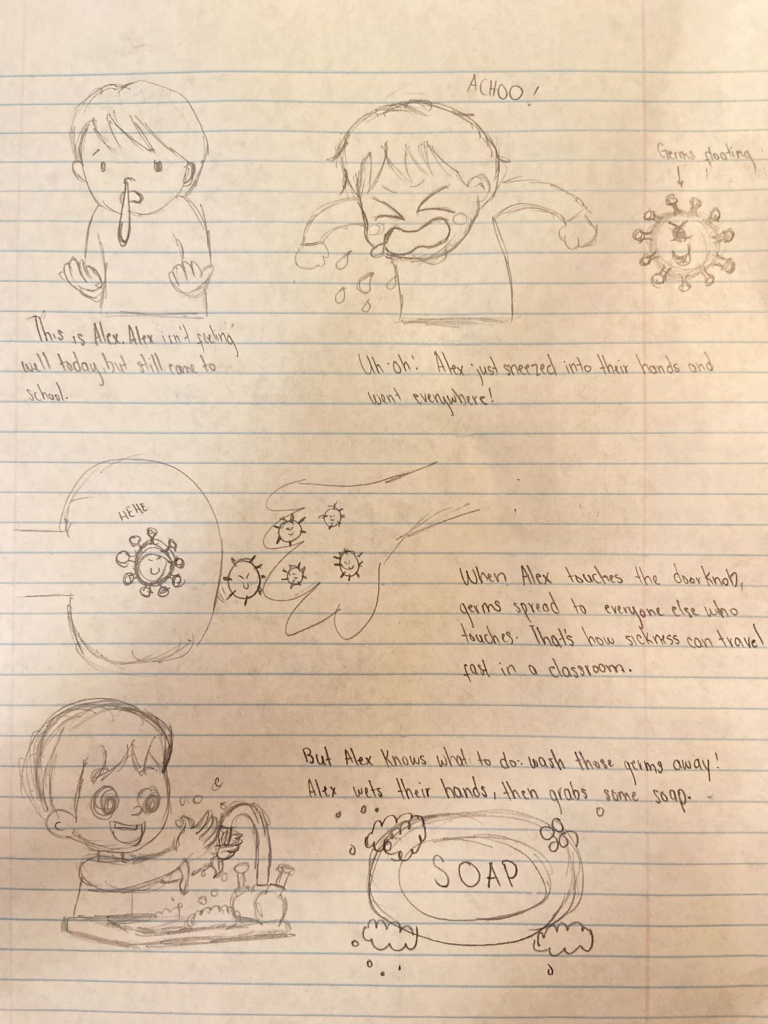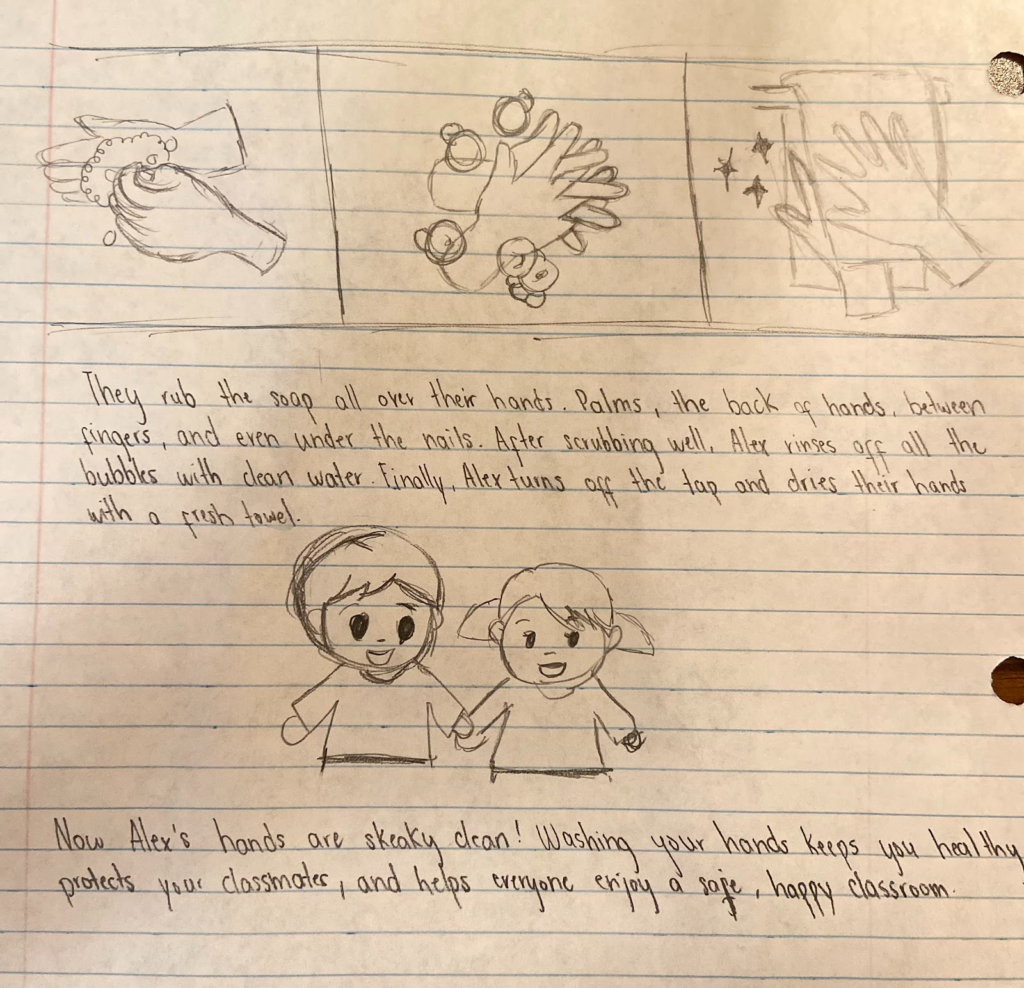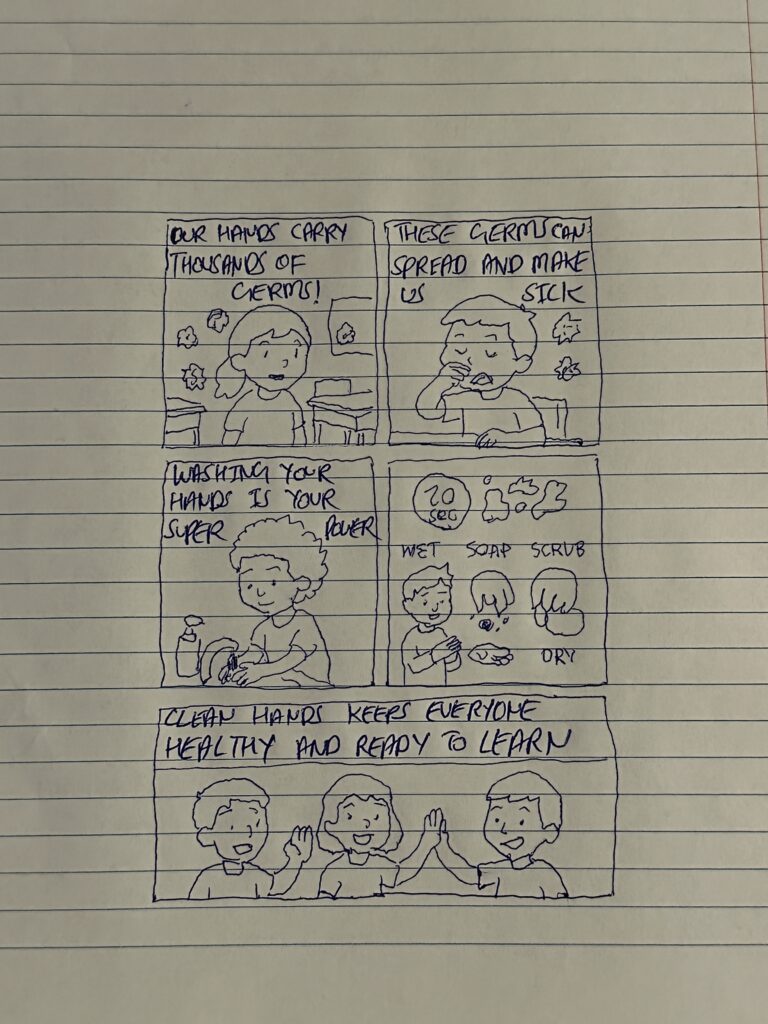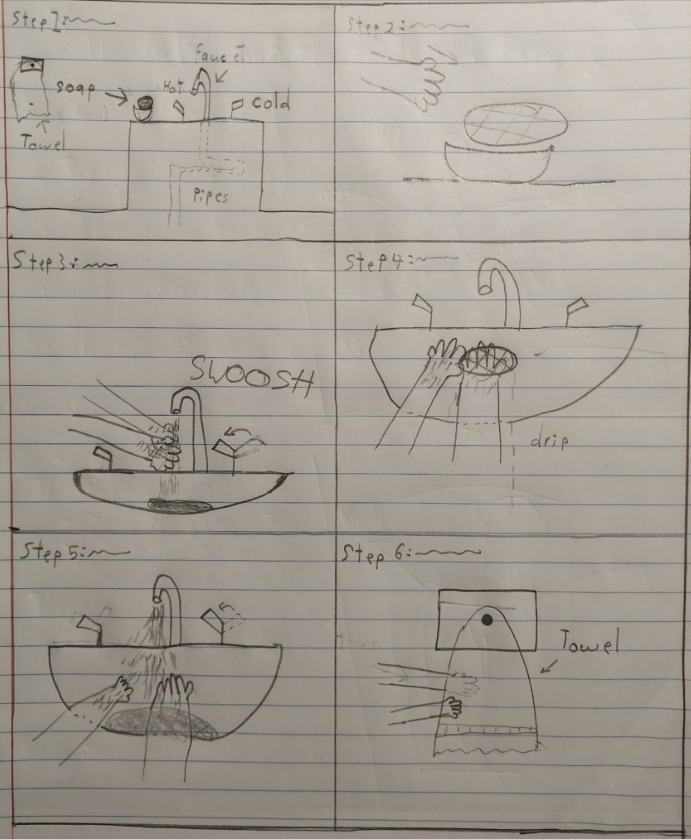Challenge B: Video

Healthy Habits: Hand Hygiene
Stop the Spread, Wash Your Hands Right!
Updated: October 22, 2025
Authors: Neeraj Neeraj, Bashar Kabd, & Therese Taruc
This blog post is a documentation of the process we underwent to create three 1-minute videos about our topic. This learning pod is composed of three members: Bashar Kabd, Neeraj, and Therese Taruc. We chose this topic because we were all familiar with it from a young age, and we wanted to explore hand hygiene in more detail as part of our project. Our goal is to expand our knowledge about the topic by explaining it in a quick and concise way. Overall, we are excited to see what we find, and how our videos turn out in the end.
THE PROCESS
Understand (Discover, Interpret, Specify)
DESCRIBE THE CHALLENGE:
Elementary school children need to learn the importance of proper handwashing techniques to protect themselves and others from spreading germs and illnesses. This helps them stay healthy, reduce the spread of illness and diseases, and they feel confident in taking responsibility for their hygiene.
CONTEXT AND AUDIENCE:
Audience
A typical audience is made up of elementary-school students (aged 5-12 years old). Students will be able to watch the video as part of class assignments or in-class activities and possibly as part of a guest speakers activity. Some extreme audience cases include students with learning difficulties, as well as visual or auditory problems.
Needs
Elementary school students completing this assignment or activity will need to watch over the videos and demonstrate their ability to wash their hands from start to finish. For students with hearing problems, the video can be uploaded to youtube, and captions can be shown. For students with sight problems, the guest speaker or teacher can provide the students with a verbal description of certain steps, as well as help the student practice hand washing. For students with learning difficulties, the task can be broken down into smaller and easy to digest steps, and explained in a simplified way.
Goals
The goal for the students is to complete the assignment or activity and learn how to wash their hands at the bathroom sink without assistance. This will help them develop better hygienic habits, reduce likelihood of sickness, and stay clean. Moreover, the elementary schoolers will get closer to their classmates as they learn to wash their hands together during the activity.
Motivations
Students will feel motivated to complete the assignments for a handful of reasons. The first is that the videos will be designed to be appealing to elementary-schoolers. There will be colorful graphics and simple narration. The second reason is that students will enjoy completing the activity with their friends.
POV STATEMENT:
An elementary school student needs to learn healthy handwashing habits through clear, step-by-step instructions so they can stay healthy, prevent the spread of germs, protect both themselves and their friends, and promote a clean, healthy classroom environment.
LEARNING OBJECTIVES:
Primary Objectives
Healthy Habits
- Students will learn when handwashing is necessary (e.g., before eating, after bathroom use, after coughing/sneezing)
- Students can follow clear, step-by-step instructions to wash their hands correctly
Health Awareness
- Students will understand the importance of handwashing to prevent the spread of germs and illnesses
- Students can recognize how personal hygiene affects their both their health and the health of their classmates
Sub-Objectives
- Students can develop a positive attitude towards personal hygiene and incorporate their hand hygiene even outside of the classroom thereby promoting lifelong healthy practices
- Students can feel motivated to wash hands regularly because the activity is presented in a fun and engaging way
Plan (Ideate, Sketch, Elaborate)
IDEATION:
The main objective of the brainstorming stage was to find different types of methods through which we can make the concept of hand hygiene both easy to understand and visually engaging for the students in elementary school. We found various resources highlighting the importance of handwashing practice, but the ones that stood out to us were the Centers for Disease Control and Prevention (CDC) and the World Health Organization (WHO), which provided the foundation for proper handwashing steps. Other than written resources, we dove into the educational short videos designed for the children, as well as the posters and charts in the classrooms on the topic of hand hygiene. These resources highlighted effective strategies, such as colorful visuals and demonstrations, while avoiding common mistakes like overloading information or using technical terms that are hard to understand.
From this process emerged three potential prototypes:
- Instructional video – a short and straightforward video/tutorial teaching the correct handwashing techniques to students.
- Scenario-based video – a short story with the main character in the centre explaining the importance of hand hygiene.
- Explanatory Video – a small approach with animations and playful script, which explains why hand-washing matters by visually showing germs, and each step will come with narration and adequate visual cues.
The most promising prototype that we found is the explanatory video, because this type of video is the combination of engaging visuals and narration, with clear step-by-step information that makes the information easy to understand. This approach also reinforces the importance of hand-washing practice with clear guidelines, helping to build understanding and motivation among elementary school students.
STORYBOARD & SCRIPT:
Scenario Storyboard #1 – Therese Taruc
Title: Alex and Handwashing – SCRIPT:
Sniffly and sick Alex
Narrator: “This is Alex. Alex isn’t feeling very well today, but still came to school.”
Alex sneezes into his hand
Narrator: “Uh oh! Alex just sneezed into their hands!”
Alex touches a doorknob and germs can be seen attaching
Narrator: “When Alex touches the doorknob, germs spread to everyone else who touches it. That’s how sickness can travel fast in a classroom.”
Alex at sink doing step-by-step handwashing at the sink on a chair (maybe he’s small)
Narrator: “But Alex knows what to do: wash those germs away! Alex, wets his hands then adds some soap. He scrubs the soap all over his hands. Palms, back of hands, between fingers, and even under his nails. After scrubbing well, Alex rinses off all the bubbles with clean water. Finally, Alex turns off the tap and dries his hands with a fresh towel.”
Alex in classroom with other students
Narrator: “Now Alex’s hands are squeaky clean! By washing your hands, you protect yourself and your classmates, which helps everyone stay healthy and enjoy a safe, happy classroom.”
Alex and Handwashing – STORY BOARD:


Explanatory Storyboard #2 – Neeraj Neeraj
Title: The Power of Clean Hands! – SCRIPT
Scene 1 – The Background is a classroom; animated germs are moving around in the space above the children. Narrator: “Did you know that our hands can carry thousands of invisible germs? They travel with us everywhere—on doorknobs, desks, and even our phones!”
Scene 2– one of the students starts sneezing and touching the desk. Narrator: “When we don’t wash our hands, these germs can spread and make us or others sick.”
Scene 3- Then the child stands up and goes to the sink. Narrator: “But washing your hands properly is like having a superpower—it can stop germs in their tracks!”
Scene 4- an animated picture/chart comes up showing 5 steps of hand washing: Wet – Soap – Scrub – Rinse – Dry. Narrator: “Just wet your hands, add soap, scrub for 20 seconds, rinse well, and dry completely.”
Scene 5- students in the classroom feel happy and start high-fiving each other. Narrator: “Clean hands keep everyone healthy, happy, and ready to learn!”
The Power of Clean Hands! – STORYBOARD

How-to Video Storyboard #3 – Bashar Kabd
Title: Step-By-Step Handwashing Techniques – SCRIPT
- Step 1: go to the nearest sink
- Step 2: grab the soap
- Step 3: turn the water on to wet your hands, then turn it off again
- Step 4: rub your hands together and around the soap, getting it everywhere
- Step 5: run water over your hand until there is no more soap
- Step 6: turn the water off and dry your hands with a nearby towel
Step-By-Step Handwashing Techniques – STORYBOARD

PRINCIPLES APPLIED:
Coherence and Signaling Principle
We used coherence principle to guide and ensure that each video avoided unnecessary information, sounds, and visuals so that the view can focus on the key message. In Alex and Handwashing, only relevant narration and simple animations are included, while avoiding background distractions. In one of the scenes, it is shown that the hand washing techniques are numbered thereby applying the signaling principles to guide the viewer the proper correct sequence of handwashing actions. By maintaining coherence and using clear signals such as the visual cues, these can support learners in processing information in a clear, structured manner where the viewer’s cognitive process and extraneous load is reduced and efficiently used (Ragazou & Karasavvidis, 2023).
Segmenting Principle
Narration and visuals are presented at the same time in order to reinforce the viewer’s understanding of handwashing. In Alex and Handwashing, the narration about “scrubbing between fingers and under nails” appears right as Alex begins to perform those actions. All across the videos, concepts are segmented into parts where the story is divided into clear, logical steps. These include: introducing the character (Alex) and problem (germs), providing a solution (washing), and showing the outcomes (clean hands and classroom). This chunking makes the process easier for learners to follow and retain the concept and material (Mayer et al., 2019). Through demonstrating the sequence of actions, the viewer can build understanding step-by-step, which will help them recall and perform the proper washing habits.
Personalization and Redundancy Principle
The other two principles that helped us positively in making our video were the personalization and redundancy principles. To increase engagement and motivation among our young audience from elementary school, we used a friendly and soft conversational tone. “You can be a handwashing hero!” is one of the examples used in the video, which helps to build an emotional connection between both the viewer and the content, which, as a result, encourages active participation. We also took steps to avoid redundant on screen-text, which might be negatively impacting the narration, but instead we used visual cues such as “Wet – Soap – Scrub – Rinse – Dry” to reinforce the main idea without cognitively overwhelming the learners. These strategies completely fall under the recommendation by Mayer (2019), which uses the text to add value, not just to repeat the narration.
Multimedia Principle
The Multimedia principle overviewed our overall design, the intentional use of words and visuals to enhance the engagement and understanding of our topic. In the video, there was a scene where the narrator talks about staying healthy, and in the background, germs started to disappear. This can help learners connect cause and effect more easily and efficiently. To make the learners’ experience enjoyable and memorable, we used a combination of animated images, voiceovers, and cheerful background music. Together, these principles helped us to ensure that our project was educational and grounded in evidence-based learning strategies that promote lasting behavioral changes.
PROTOTYPE
Preliminary Designs (Pilot Prototype)
Video #1 (Therese) – Alex and Handwashing
Video #2 (Neeraj) – Benefits of Hand Washing
Video #3 (Bashar) – Step-By-Step Handwashing Techniques
FINAL PRODUCT
Video Submission #1
Video Submission #2
Video Submission #3
PEER FEEDBACK:
Neeraj
In the feedback given by Alexis Moore, our group has the strong knowledge of the principles of Mayer’s Multimedia learning principles and we implemented them throughout the videos. She also highlighted that our blog post shows good organisation and we connected the principles of multimedia such as coherence, signaling, segmenting, and personalization to our story boards smoothly. Alexis also liked the fact that our topic is very simple yet equally important. She notices that the nature of our topic is very clearly suited for our targeted audience including young children which is an important age group for developing healthy hygiene habits.
Alexis suggested that we should add a reflective prompt in a question format asking “how many times do you wash your hands” to make it more memorable and engaging for students. It can also be reflective as it will allow students to reflect on their own hygiene practices and habits. This suggestion is influenced by the principles of personalization and generative learning as it prompts an active reflection.
Bashar Kabd
According to Ali Raffi, my portion of the blog post had multiple strengths, as well as some areas of improvement. For strengths, Ali Raffi found the visuals clear and engaging for the target audience, as well as easy to follow for elementary students. Multimedia principles have been applied to my video in a thoughtful manner. For weaknesses, my video lacked an introduction that explains why handwashing is good, and I did not have a diverse list of characters in my video (one character).
According to Yiran Han, My storyboard reflects strong alignment with Mayer’s multimedia principles. Namely the segmenting, coherence, and personalization principles, which reduced cognitive load and increased engagement. On another note, Yiran Han also suggested improving the blog post by introducing my How-to video in a way that connects it to the other two videos. Furthermore, Yiran Han suggested making the video more inclusive by adjusting narration speed, among other things to help learners with accessibility issues.
Therese Taruc
The feedback we received highlights that our prototype caters to our audience (elementary learners) and task by using a short and step-by-step kind of videos with clear narration and simple visuals. It acknowledges coherence, segmenting, and other multimedia learning principles. Likewise, it was highlighted that it can be accessible for learners with hearing and vision needs. The feedback suggests adding a visual timer or progress ring to show the 20 seconds of scrubbing. They also suggested maintaining consistent camera framing and steady motion, and adding brief checks that reinforce key steps.
The second feedback emphasized that our prototype was clear and engaging which properly teaches elementary students through animated visuals and clear narration. The videos were effective in using coherence, signaling, and segmentation principles while keeping accessibility features like captions and guidance for diverse learners. The peer suggested slightly slowing down the pacing of sequences to give learners more time to process each step and to maintain the same colors and animation style across all videos for visual coherence. They also suggested adding a short recap at the end of each video.
Reflect and Refine
TEAM REFLECTION:
Some of the things that worked well for us were the application of multimedia principles in our blog post. The peer reviewer also approved of our use of the segmenting and coherence principles. With that being said, there are some areas of improvement that we can focus on. Mainly, the reviewers suggested making our prototypes more accessible for students with learning difficulties, as well as make our prototypes flow together more cohesively.
Some revisions we included in our revised prototype included making the How-to video simpler by adding a timer to display how long washing hands takes. Furthermore, another revision is stabilising the camera, as to reduce motion blur and make viewing easier.
There were several key issues raised by my peers in peer feedback, which helped me to understand more deeply the consequences of the decision on the learning outcomes. One of the areas that was highlighted in the feedback was to ensure accessibility for diverse learners, such as learners who have visual or cognitive challenges. One of the resources that I capitalized on was the use of captions and clear narrations, but groupmates recommended using more explicit visual cues or using a timer when showing the tutorial for handwashing to ensure that learners were guided throughout the 20-second handwashing process. I made sure to reinforce this idea by adding a special visual cue in my video during the handwashing process, highlighting the five steps of handwashing. Other feedback I found interesting was on the issue of cohesion between all videos; there were variations in colors and styles among them. To solve this issue, I used resources such as consistent background music and color themes with easy-going narration to ensure a smoother and engaging learning experience.
One of the strengths of these types of multimedia for learning is that they clearly and strongly align with the principles of Mayer’s Cognitive Theory of Multimedia Learning (CTML). The help of resources like clear narration, animations, engaging visuals, and cheerful background music in our multimedia project helped us to reduce cognitive load and maintain the learner’s engagement. We used the principles of coherence, signaling, and segmenting in our videos to reduce the use of excess information and to make sure that learners can easily focus on the main content without any distractions. One example would be that we used easy-to-understand visual cues like “Wet – Soap – Scrub – Rinse – Dry” for two main reasons: to help learners follow every step and to reduce redundant on-screen text.
One of the limitations of this type of multimedia is to ensure a great balance between entertainment and educational clarity. If there is an excessive use of visual cues or background music, it can easily distract the learners from the main idea we are trying to convey. Also, the fact that not all learners may process the information or visual cues at the same speed, so there has to be adaptive pacing or interactive features to make it inclusive even for well-designed multimedia. For this specific problem, we can use the segmenting principle as explained by Mayer et al.(2019), that using segmenting learning content into smaller chunks of information can allow learners to control their pace and process information in their own way more effectively.
INDIVIDUAL REFLECTIONS:
Neeraj
In this group project, every member of the group was responsible for making their own Script, Storyboard, and Video. We divided the main idea into three parts, and each group member took one part each. Additionally, we all provided each other with valuable feedback regarding our videos and shared ideas as well. I completed ideation, and I also co-wrote the sections on Principles Applied and team reflection with Therese. Finally, I completed individual reflection. For projects like this in the future, I would recommend using a clear structure highlighting each team member’s responsibilities. Also, it would be great for team communication if we create a page with the assignment for notes and updates.
Bashar Kabd
I completed the Introduction for Phase 0, and chose the background color for the blog post. Additionally, I completed the Context and Audience sections for Phase 1. I completed my storyboard and script, prototype, and video for Phase 3. I also completed two Peer Reviews for Phase 4, and contributed to half of the Team Reflection for Phase 5.
Therese Taruc
For this project, every member made a script, video, and storyboard. I contributed on: Providing the topic, describing the Challenge, POV statement, learning objectives, co-wrote Principles Applied with Neeraj, individual and peer review reflections, formatting of the website, and dividing the work between members. Bashar contributed with: Context and Audience, Peer Feedback, Team and Individual Reflection, and visuals of the website. Neeraj contributed with: Ideation, Principles Applied, and Team and Individual Reflection. Our teamwork was organized, had effective communication, and excellent with meeting team deadlines and expectations. For future projects, we could improve by planning and scheduling group meetings through Zoom rather than relying on text (Instagram). Miscommunications can occur when responsibilities or updates are made through messages, especially if a team member is unavailable at the time. Having a live discussion would allow us to clarify our tasks and goals to ensure everyone understands the plan and address any possible questions in real time. Overall, the team was effective and demonstrated a strong collaborative environment.
REFERENCES
Mayer, R. E., Wells, A., Parong, J., & Howarth, J. T. (2019). Learner control of the pacing of an online slideshow lesson: Does segmenting help? Applied Cognitive Psychology, 33(5), 930–935. https://doi.org/10.1002/acp.3560
Mayer, R. E. (Ed.). (2014). The Cambridge handbook of multimedia learning (2nd ed.). Cambridge University Press. https://doi.org/10.1017/CBO9781139547369
Mayer, R. E., Wells, A., Parong, J., & Howarth, J. T. (2019). Learner control of the pacing of an online slideshow lesson: Does segmenting help? Applied Cognitive Psychology, 33(5), 930–935. https://doi.org/10.1002/acp.3560
Ragazou, V., & Karasavvidis, I. (2023). Effects of signaling and practice types in video-based software training. Education Sciences, 13(6), 1–14. https://doi.org/10.3390/educsci13060602